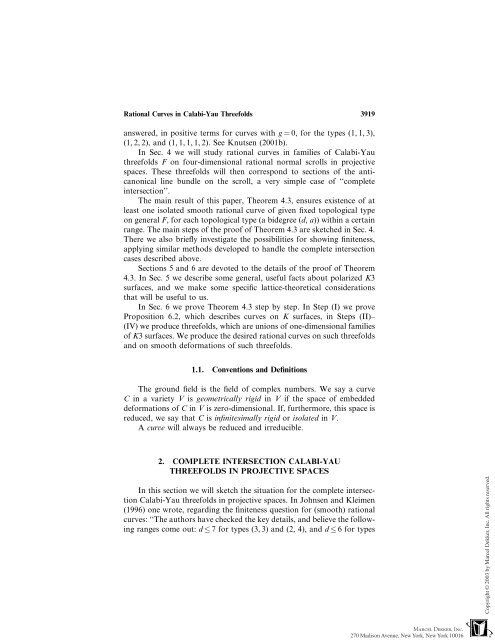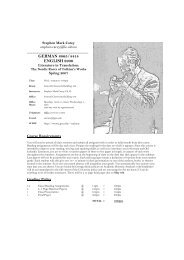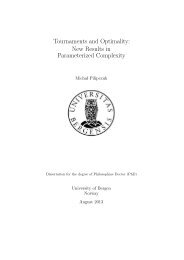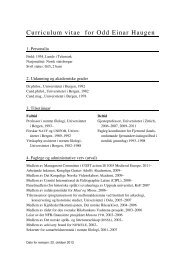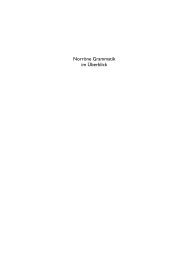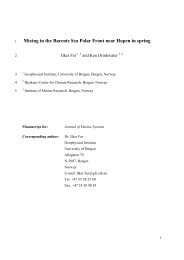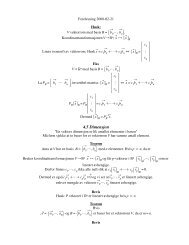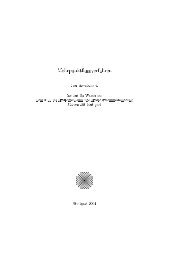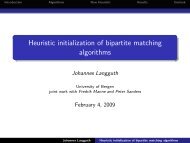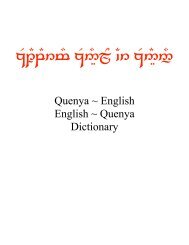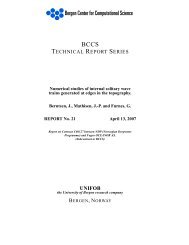Rational Curves in Calabi-Yau Threefolds
Rational Curves in Calabi-Yau Threefolds
Rational Curves in Calabi-Yau Threefolds
You also want an ePaper? Increase the reach of your titles
YUMPU automatically turns print PDFs into web optimized ePapers that Google loves.
<strong>Rational</strong> <strong>Curves</strong> <strong>in</strong> <strong>Calabi</strong>-<strong>Yau</strong> <strong>Threefolds</strong> 3919<br />
answered, <strong>in</strong> positive terms for curves with g ¼ 0, for the types (1, 1, 3),<br />
(1, 2, 2), and (1, 1, 1, 1, 2). See Knutsen (2001b).<br />
In Sec. 4 we will study rational curves <strong>in</strong> families of <strong>Calabi</strong>-<strong>Yau</strong><br />
threefolds F on four-dimensional rational normal scrolls <strong>in</strong> projective<br />
spaces. These threefolds will then correspond to sections of the anticanonical<br />
l<strong>in</strong>e bundle on the scroll, a very simple case of ‘‘complete<br />
<strong>in</strong>tersection’’.<br />
The ma<strong>in</strong> result of this paper, Theorem 4.3, ensures existence of at<br />
least one isolated smooth rational curve of given fixed topological type<br />
on general F, for each topological type (a bidegree (d, a)) with<strong>in</strong> a certa<strong>in</strong><br />
range. The ma<strong>in</strong> steps of the proof of Theorem 4.3 are sketched <strong>in</strong> Sec. 4.<br />
There we also briefly <strong>in</strong>vestigate the possibilities for show<strong>in</strong>g f<strong>in</strong>iteness,<br />
apply<strong>in</strong>g similar methods developed to handle the complete <strong>in</strong>tersection<br />
cases described above.<br />
Sections 5 and 6 are devoted to the details of the proof of Theorem<br />
4.3. In Sec. 5 we describe some general, useful facts about polarized K3<br />
surfaces, and we make some specific lattice-theoretical considerations<br />
that will be useful to us.<br />
In Sec. 6 we prove Theorem 4.3 step by step. In Step (I) we prove<br />
Proposition 6.2, which describes curves on K surfaces, <strong>in</strong> Steps (II)–<br />
(IV) we produce threefolds, which are unions of one-dimensional families<br />
of K3 surfaces. We produce the desired rational curves on such threefolds<br />
and on smooth deformations of such threefolds.<br />
1.1. Conventions and Def<strong>in</strong>itions<br />
The ground field is the field of complex numbers. We say a curve<br />
C <strong>in</strong> a variety V is geometrically rigid <strong>in</strong> V if the space of embedded<br />
deformations of C <strong>in</strong> V is zero-dimensional. If, furthermore, this space is<br />
reduced, we say that C is <strong>in</strong>f<strong>in</strong>itesimally rigid or isolated <strong>in</strong> V.<br />
A curve will always be reduced and irreducible.<br />
2. COMPLETE INTERSECTION CALABI-YAU<br />
THREEFOLDS IN PROJECTIVE SPACES<br />
In this section we will sketch the situation for the complete <strong>in</strong>tersection<br />
<strong>Calabi</strong>-<strong>Yau</strong> threefolds <strong>in</strong> projective spaces. In Johnsen and Kleimen<br />
(1996) one wrote, regard<strong>in</strong>g the f<strong>in</strong>iteness question for (smooth) rational<br />
curves: ‘‘The authors have checked the key details, and believe the follow<strong>in</strong>g<br />
ranges come out: d 7 for types (3, 3) and (2, 4), and d 6 for types


